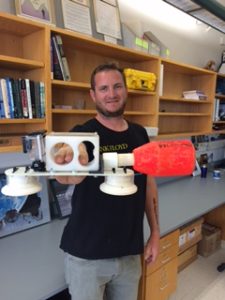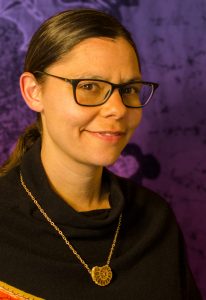MLML's Kathleen Donahue was on ABC7 News this week, commenting on how marine life may be affected by the recent sewage spill into Monterey Bay.
Watch the clip here.
MLML's Kathleen Donahue was on ABC7 News this week, commenting on how marine life may be affected by the recent sewage spill into Monterey Bay.
Watch the clip here.
Dive into the 8th Annual Whalefest Monterey with us this weekend!
MLML students will be tabling all weekend with many specimens on hand from the Pacific Shark Research Center.
On Saturday at 2pm, our emeritus ichthyologist, Dr. Greg Cailliet, will be speaking in the Wharf Theater about Monterey's subtidal fishes. His talk is titled: "Below Pacific Tides - Fishes that live in Subtidal Habitats in Monterey Bay."
Congratulations to MLML research technician, Jason Adelaars, who received the Wendell Ayers Memorial Leadership Award from the Monterey Bay Aquarium. This award recognizes one MBA volunteer diver each year for their accomplishments in ocean advocacy and conservation efforts. Mr. Adelaars was chosen this year for his work in reducing nutrient runoff into the Moro Cojo Slough, long-term oceanographic water quality monitoring, Monterey Bay sea-level rise analysis, and developing technologies to better serve estuarine, marine, and aquaculture scientists.

MLML research affiliate, Dr. Karin A. Forney, and colleagues publish a study on the disturbance effects of anthropogenic noise upon several marine mammal species, including some that are considered Critically Endangered. The paper is titled Nowhere to go: noise impact assessments for marine mammal populations with high site fidelity and was published in the journal, Endangered Species Research. The research aims to provide better means of assessing and mitigating the effects of anthropocentric noise on marine mammals.
Click here to read the paper.

MLML recent graduate Christian Denney of the Fisheries and Conservation Biology Lab is first author on a recently published study based on his thesis research. Ryan Fields and Dr. Richard Starr from MLML and Mary Gleason of The Nature Conservancy co-authored this study, titled: Development of New Methods for Quantifying Fish Density Using Underwater Stereo-video Tools.
Ross Clark, director of MLML's Central Coast Wetlands Group, writes about the effects of marine heat waves on Northern California's kelp forest ecosystems for the Santa Cruz Sentinel. Article includes quote from MLML's phycologist, Dr. Mike Graham.
Read the article here: Earth Matters: Invasion of the warm marine blob
Hosted by the Phycology Lab
MLML Seminar Room, 4pm
Open to the public

Zan Armstrong is a data visualization engineer and designer. Her work includes creating custom visualizations, both static and interactive, for analysts and scientists to enable them to make new discoveries in their data. She is most interested by identifying what characteristics of the data might be most analytically/scientifically important, and finding ways to reveal those characteristics visually. Zan also enjoys finding other ways to see familiar data that reveals a different perspective or illustrating situations in which the "obvious" understanding of the data is misleading or masks some deeper truth.
Picking the visual form for a data visualization is a decision about what part of our data we care most about. Should we highlight outliers? Focus on the densest parts of the data? Ignore numbers under a certain threshold? Look at values or differences? The right form depends on what we believe is most important to see. Zan Armstrong will describe the thought process behind data-driven design decisions from her work and share her 5 top recommendations for making more effective visualizations for scientific discovery (including code snippets in R and/or Python).
Hosted by the Ichthyology Lab
MLML Seminar Room, 4pm
Open to the public
Allen Andrews joined the Life History Program of the Pacific Islands Fisheries Science Center in 2009. He came to Hawaii from Moss Landing Marine Laboratories (MLML) in California where he operated the Age and Longevity Research Laboratory for 12 years. He earned a M.S. degree in Marine Science from MLML in 1997 and in 2009 he finished a Ph.D. in Ichthyology and Fisheries Science at Rhodes University, South Africa. His dissertation presented validated age and growth of the Patagonian toothfish (Chilean sea bass) and orange roughy.
His area of expertise involves age estimation and validation of fishes and invertebrates using growth zone counting and radiochemical techniques (i.e. lead-radium dating) and bomb radiocarbon dating. Recent works involved bomb radiocarbon dating of several shark species, the endangered white abalone, hawksbill sea turtle, and fishes of Indo-Pacific regions. Allen's work with the Life History Program at NOAA Fisheries began with applying these techniques to dating opakapaka (Hawaiian pink snapper), and has continued with applications to other fishes of the Hawaiian Archipelago, as well as national and international collaborations on fishes and corals of the Gulf of Mexico, Great Barrier Reef, and Mediterranean. As an Affiliate Faculty member of the Oceanogrpahy Department and the Marine Biology Graduate Program at University of Hawaii, Manoa, Allen has fostered research with students involving deep-sea fishes and tropical snappers. Other interests are with photography, astronomy, and world travel. For more information please visit: “astrofish.me”
Longevity of blue marlin (Makaira nigricans) remains unresolved. Use of fin spines and sagittal otoliths for age reading has led to unconfirmed longevity estimates of close to 20 years. Age validation has been elusive because large individuals are rare and a technique that can be applied to the structures that provide estimates of age was absent. Use of otolith chemical signatures has been limited by sagittal otoliths that are very small—whole otolith mass of adult blue marlin can reach 10 mg for the largest fish. Recent advances in the detection limits of radiocarbon (14C) with accelerator mass spectrometry—coupled with recently acquired knowledge of marine bomb 14C signals spanning the tropical Pacific Ocean—have led to an opportunity to age blue marlin from small amounts of otolith material. In this study, otoliths from a recently collected 1245 lb. (565 kg) female blue marlin at 146 inches (3.71 m) lower jaw fork length were analyzed for 14C. Using a series of deductions in the bomb 14C dating method the age of this “grander” blue marlin was confirmed.
Hosted by the Vertebrate Ecology Lab
MLML Seminar Room, 4pm
Open to the public

Danuta Maria Wisniewska is a bioacoustician and foraging ecologist interested in how marine animals negotiate their surroundings and forage in their heterogeneous and rapidly changing habitats. Her research is centered on fine-scale empirical studies using multi-sensor biologging tags. Danuta is an oceanographer turned biologist. After an undergrad in oceanography at University of Gdansk in Poland, she completed an Arctic Biology program at the University Centre in Svalbard, Norway. She then joined the Marine Bioacoustics Lab at Aarhus University, Denmark, where she worked on sensory ecology of echolocating toothed whales. After earning her PhD degree, she moved to the Section of Marine Mammal Research at Aarhus University, where she worked on the effects of anthropogenic noise on marine mammals. She is currently a postdoctoral fellow in Jeremy Goldbogen’s lab at Stanford University’s Hopkins Marine Station.
Size dependence of metabolic rate, where smaller animals generally exhibit higher mass-specific metabolism, is a major factor influencing how animals interact with their environment. Whilst large body size necessitates high absolute energy intake, it also grants low relative rates of energy use per unit body mass and, therefore, many physiological and ecological advantages. Such size-related functional constraints ultimately shape animal behavior, performance and life history. In this talk, I will discuss how these body size trade-offs affect foraging performance of cetaceans, from harbor porpoises to sperm whales and blue whales. I will focus on how biologging technology has enabled us to address this.
Hosted by the Invertebrate Zoology and Molecular Ecology Lab
MLML Seminar Room, 4pm
Open to the public

Danna Staaf fell in love with cephalopods at the age of ten. She began to keep them as pets in a home aquarium, learned to scuba dive in order to meet more of them in the wild, and eventually completed a Ph.D. on squid at Stanford University's Hopkins Marine Station. Her first book, Squid Empire: The Rise and Fall of the Cephalopods, was named one of the best science books of 2017 by NPR Science Friday. She lives in San Jose, California, and works as a freelance science writer and educator.
Before there were mammals on land, there were dinosaurs. And before there were fish in the sea, there were cephalopods—the ancestors of modern squid and Earth’s first truly substantial animals. With dozens of tentacles and formidable shells, they presided over an ancient undersea empire. These mysterious, intelligent, and adaptable creatures are the heroes of an epic adventure spanning hundreds of millions of years, from the primordial ocean to the calamari on your dinner plate.
The story of squid evolution will be told interleaved with "the story behind the story": strategies, examples and practical tips for getting out the word about your favorite science, no matter how intricate or obscure.

